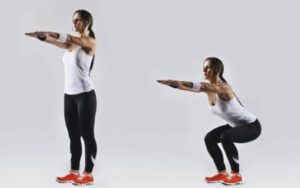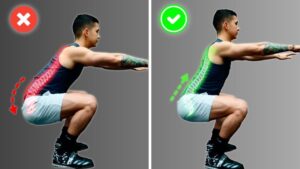If you’ve spent any time researching simple yet powerful exercises, you’ve likely come across the squat. Praised for its ability to target major muscle groups, boost lower-body strength, and support overall fitness, squats have earned their place in nearly every workout routine. But what happens if you take it a step further and decide to do squats every single day for one month? From increased muscle tone to improved stability, the transformations can be quite impressive. Let’s explore the journey, benefits, technique, and precautions you should consider before committing to a 30-day squat challenge.
The Importance of Squats

Squats are known as a compound exercise, meaning they work multiple muscle groups at once. Here’s what you’ll be targeting:
- Quads (Quadriceps): These are the primary movers in a squat, helping you extend and straighten the knee.
- Glutes (Gluteal Muscles): Squats help shape and strengthen your buttocks, which can improve both posture and power.
- Hamstrings: The back of your thighs also see significant engagement, aiding in overall leg strength.
- Core Muscles: Although you may not feel a squat in your abs the way you would with crunches, your core activates to stabilize your spine and maintain balance.
- Lower Back: Proper squat form requires a neutral spine, which means the lower back muscles support and stabilize your upper body.
Because it involves many muscles simultaneously, the squat is a time-efficient and metabolically demanding exercise. This means you’ll burn calories not only during your workout but also afterward, thanks to increased muscle activity.
Potential Benefits of Doing Squats Daily for 1 Month

1. Enhanced Muscle Tone and Strength
Performing squats every day can rapidly build strength in your lower body. Over the course of a month, you’ll likely notice:
- Stronger Quads and Glutes: As these muscles are used daily, expect them to become firmer and more defined.
- Improved Lift in Daily Activities: Carrying groceries, climbing stairs, and playing sports might feel noticeably easier.
- Better Balance: Your stabilizing muscles become more adept at keeping you upright, reducing the risk of falls or injuries.
2. Better Posture and Core Stability
Squats aren’t just about the legs. They also require a strong core. Doing squats consistently engages the abdominal and lower back muscles, leading to improved posture. After a month of daily squats, you may find yourself sitting and standing taller, thanks to stronger supporting muscles around your spine.
3. Increased Calorie Burn
Squats are a compound exercise that challenges multiple muscle groups. This means they can raise your heart rate significantly—even though they’re not traditionally classified as cardio. Over time, building muscle increases your resting metabolic rate, potentially helping you burn more calories throughout the day.
4. Joint and Bone Health
When performed with the correct technique, squats can strengthen not only muscles but also bones and connective tissues like ligaments and tendons. Regular weight-bearing exercise helps promote bone density, which is especially important as we age. However, it’s crucial to use proper form, especially if you have existing joint issues—improper squatting can do more harm than good.
5. Mental Discipline and Habit Formation
Committing to daily squats can also boost your mental resolve. The discipline required to stick to a routine helps build a consistent exercise habit. By the end of the month, you’ll have greater confidence in your ability to set and achieve fitness goals.
How to Perform Squats Correctly

Step-by-Step Technique:
- Set Your Stance: Stand with your feet about shoulder-width apart. Your toes can point straight ahead or slightly outward, depending on your comfort and hip mobility.
- Engage Your Core: Tighten your abdominal muscles to protect your spine.
- Begin the Descent: Push your hips back and bend your knees, lowering your body as if you’re about to sit in a chair. Keep your weight in your heels and maintain a neutral spine.
- Depth Matters: Aim to lower your thighs until they’re at least parallel to the ground. If your mobility allows, you can squat deeper, but avoid rounding your lower back.
- Drive Up: Exhale and push through your heels to return to a standing position. Squeeze your glutes at the top for maximum benefit.
Common Mistakes to Avoid:
- Allowing Your Knees to Cave In: Keep your knees aligned with your toes.
- Rounding Your Back: Maintain a neutral spine throughout the movement.
- Lifting Your Heels: If your heels come up, work on ankle mobility or shorten your squat depth until you can keep them down.
Crafting a 1-Month Daily Squat Routine
1. Start With Bodyweight Squats
If you’re new to squats, begin with bodyweight squats to perfect your form. Gradually increase the number of squats as you feel more comfortable. Aim for something like 3 sets of 10-15 squats each day in the first week.
2. Add Variations
To keep your muscles challenged and prevent a plateau, incorporate different squat variations:
- Sumo Squats: Stand with your feet wider than shoulder-width and toes pointed outward. This emphasizes the inner thighs and glutes.
- Jump Squats: Add a plyometric element by exploding upward into a jump before landing back into a squat.
- Pistol Squats: For advanced practitioners, a single-leg squat can greatly increase core and stability challenges.
- Goblet Squats: Hold a dumbbell or kettlebell at chest level to add resistance.
Varying your stance and resistance also helps you avoid overuse injuries.
3. Track Your Progress
It’s motivating to keep a log of the number of squats you do each day and any added resistance you use. This makes it easier to see improvements and stay committed to your goal.
What to Expect After 1 Month
- Noticeable Lower-Body Strength: Your quads, hamstrings, and glutes will likely feel more powerful, and daily tasks may seem easier.
- Improved Muscular Endurance: You’ll find you can do more squats without feeling fatigued.
- Enhanced Muscle Tone: Although individual results vary, some people report a firmer, more lifted appearance in their legs and buttocks.
- Better Balance and Posture: With consistent core activation, you might stand taller and move more confidently.
- Potential Weight Loss or Body Composition Changes: Squats can help burn calories, but results also depend on your overall diet, metabolism, and other lifestyle factors.
Precautions and Considerations
- Rest Days: While the goal is to perform squats daily, it’s important to listen to your body. If you experience excessive soreness or joint pain, consider reducing volume or taking a rest day.
- Warm-Up and Cool-Down: Perform light stretching or dynamic warm-ups to prepare your muscles and joints. After squatting, cool down with static stretches to reduce muscle tightness.
- Proper Form First: Never sacrifice form for a higher rep count. Incorrect movement patterns can lead to injury and negate the benefits of the exercise.
- Progress Gradually: If you’re new to squatting, gradually increase the number of reps or add light weights over time. Jumping into high-intensity squats too quickly can cause strain.
- Consult a Professional: If you have existing knee, hip, or back issues, consider consulting a physical therapist or certified trainer before starting a 30-day squat challenge.
Final Thoughts
Doing squats every day for a month can yield tangible improvements in lower-body strength, core stability, and overall fitness. You may notice firmer muscles, better posture, and increased mental discipline from sticking to a daily routine. However, it’s crucial to maintain proper form, remain mindful of any discomfort, and tailor the intensity to your fitness level. Squats might be a straightforward exercise, but their potential to transform your physique and boost your functional strength is substantial—especially when practiced consistently and correctly.
Are you ready to feel the difference? Commit to a 30-day squat challenge, track your progress, and watch your lower body and core grow stronger. Whether you choose traditional bodyweight squats, weighted goblet squats, or explosive jump squats, this versatile exercise has the power to take your fitness journey to new heights. Grab a calendar, set daily squat goals, and get ready to see—and feel—the transformative results.
